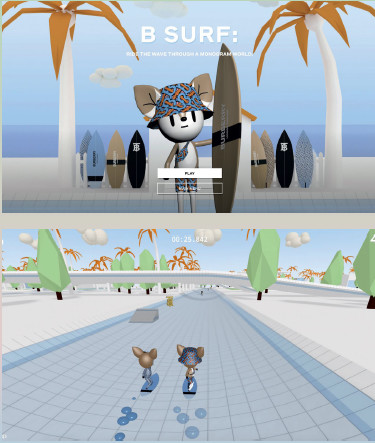THE REALMS OF FILM, MUSIC AND ENTERTAINMENT HAVE LONG EMBRACED THE DIVERSE MEDIUM THAT IS ANIMATION AND – GOING BY ITS RECENT RASH OF CGI-LED CONTENT AND FORAYS INTO GAMING (YES, GAMING) – FASHION IS RAISING ITS STAKES IN THE SCENE TOO. THE MILLION (MAKE THAT BILLION) DOLLAR QUESTION: IS THIS SIMPLY A TREND OR WILL IT LEAD TO NEW HORIZONS? AND WHAT DOES IT MEAN FOR ALL OF US? KENG YANG SHUEN REPORTS.


Let me be the first to say that I’m not very well-versed in technology; Luddite might be a better term. But when researching this story, I reconsidered: Even if I knew next to nothing of the wizardry used to power the many forms and applications of animation, I am at least intimately familiar with its many end-products, which cover everything from favourite childhood cartoons and movies (the 1989 Studio Ghibli anime Kiki’s Delivery Service) to social media content such as GIFs and the computer games that I consume on a daily basis (anyone else up for some Dota 2?). What that made me realise: We’re continually surrounded by one form or another of animation, which – at its most fundamental – is the art of manipulating otherwise static figures and objects to appear as moving images.
Take one of the biggest phenomenons to emerge during the recent lockdown period, the social simulation game Animal Crossing: New Horizons. Within its world, player-controlled avatars live on their own islands and – more importantly for fashion fiends – possess the ability to customise their wardrobe. Many even recreated their favourite designer looks using the game’s Photoshop-esque tool, and the feel-good effects of it all in a world starved of occasions and events to dress up for have been astounding.
One user interviewed by The Business Of Fashion sums it up best: “Dressing up your character on Animal Crossing is in a way almost more rewarding than shopping because there’s no limit to how you can dress. I probably won’t fit into a lot of the clothes from (Japanese cult denim brand) Kapital, but my character can wear all of its pieces.”
The Nintendo Switch game has taken the world by storm, moving more than 22 million units since it launched in March, and major fashion and beauty houses have taken notice: Valentino and Marc Jacobs dropped custom “outfits” for avatars to don, while Givenchy offered its most popular makeup products. Meanwhile, Instagram accounts that document Animal Crossing looks such as @nookstreetmarket – its New York-based founders include the model Fernanda Ly – and @animalcrossingfashionarchive count tens of thousands as followers.
That said, Animal Crossing itself is but one platform. The start of the year saw gamers from the elite gaming organisation Fnatic grace the front row of Gucci’s F/W’20 men’s show in Milan. Last October, Louis Vuitton announced that creative director Nicolas Ghesquiere would be designing virtual outfits (as well as a matching real-life collection) for Qiyana and Senna – avatars in what is likely the world’s most played PC game, League of Legends. And ever the astute digital navigator, Burberry opted to launch its own game, B Bounce, in the same month, which has reportedly since been played by over two million people.
It doesn’t take a rocket scientist to figure out why fashion brands are muscling into gaming and esports. While a real-life jacket from the Louis Vuitton x League of Legends collection would cost four figures and up, the digital version goes for a much more palatable $10 to $15. Brand exposure aside, the hope is that a digital customer graduates to become one IRL eventually.
"Balenciaga Loops is a series of alternately fun and trippy video art/music mixes that the house launches monthly on its Youtube channel. Each animation taps on different artists; here, the works of Stockholm-based graphic designer Carl Herner, featuring characters at a rave decked out in oversized interpretations of Balenciaga wares."




The gaming industry is, to put it bluntly, a massive cash cow that has no limit in sight. Esports analytics firm Newzoo states that – as of this year – there are 2.7 billion gamers worldwide who are all in projected to spend US$159.3 billion (S$216.1 billion) on games by the end of 2020. While most industries are gasping for air (fashion not exempted) and in need of government bailouts, gaming is one of the few that’s positively thriving – its number of users is up 46 per cent on desktop and 17 per cent on mobile, according to gaming development platform Unity. And why not? In the same way that fashion has traditionally built mythologies around promised fantasies, games are the perfect avenue for those seeking out immersive forms of entertainment and escapism from dreary months-long lockdowns.
Sheer business firepower aside, gaming is also potentially the new mother lode for cultural cachet. If streetwear, which has dominated fashion for the past decade, already feels like it’s on the down and out, and social media is oversaturated, then why not gaming? Still labouring under the stereotype that gaming is only the purview of geeky adolescent boys? Think again. A sizeable portion (35 per cent) of this 2.7 billion-strong pie lies in the coveted 21-35 age group, according to market researcher Statista with women making up nearly half of this demographic. Fashion naturally gravitates towards where the youth are.
Any reticence towards embracing animation may all boil down to image. “I think there’s still this assumption that the 3-D/CGI world, such as games, comics and other ‘low brow’ mediums, are populated by a certain archetype of enthusiast, usually a white straight male cliche like the Comic Book Store Guy from The Simpsons,” says Singapore media artist Brandon Tay. “But my experience is that these worlds are populated by diverse voices that are both clued in on the pulse of culture, and are often the early adopters of trends yet to break into the mainstream.”
Likewise, the most commonly associated application for animation – cartoons and assorted entertainment mediums – remains unable to shake the stigma of being perceived as, well, child’s play. Just take 2019’s hit remake of The Lion King, which grossed more than US$1.6 billion (S$2.17 billion) and would have been the year’s highest grossing animated film – only Disney and its director Jon Favreau controversially refused to label it as so. While no official reasons came forth from the mouse house, there has been speculation that the move was to avoid competition at the Oscars within its own formidable slate of works (Toy Story 4, Frozen 2) and, more importantly, to steer clear of the negative association with children’s content that persists today (the irony of it all).
Let’s be honest: What is perceived as geeky (gaming) and childish (cartoons) has not been the traditional image fashion and luxury seeks to clad itself in. To stay relevant though, brands at all levels of the market are compelled to find alternative channels of storytelling. Animation, with its wide-ranging applications, already has a vast and diverse audience. It also possesses in spades what fashion always searches for: novelty. And to put it plainly: It’s pure fun, period.
Outside of gaming, there have been increasing ventures into content creation and branding. Balenciaga has been releasing monthly audio-visual videos called Balenciaga Loops, featuring wavy animations by different artists on its own Youtube channel since last April. Virgil Abloh showcased an animated short film, The Adventures of Zoooom with Friends, as a prelude to Louis Vuitton’s men’s S/S ’21 show, while homegrown footwear giant Charles & Keith debuted its first illustrated campaign for its F/W ’20 collection, accompanied by animated videos of the drawings. “Fashion is a forever evolving industry that is a reflection of the world’s trends and progress... (hence) the decision to create an illustrated campaign, which was birthed out of challenges faced given the current climate,” says Emmanuelle Mace-Driskill, Charles & Keith’s executive director of planning and product strategy.
In what may be a preview of the future for fashion display, this May saw the world’s first fully 3-D fashion show courtesy of the US-based Congolese designer Anifa Mvuemba, who founded the contemporary label Hanifa. Taking it upon herself to learn 3-D rendering software during the lockdown, Mvuemba’s designs were unveiled via Instagram Live. The effect was both ghostly (the avatars were invisible and marched against an all-black background) yet impressively realistic. Despite the avatars’ invisibility, they were so well-contoured and moved with such lifelike motions that one could easily picture a real person wearing the garment and how it would look in action. And while it’s true that one could experience the same and more in a real-life fashion show, the issues that can crop up with one – from the managing of resources to ensuring representation of races, ages and sizes – remain. With CGI and other software though, the power of world-building is in the creator’s hands, points out motion designer Clement Chia.
That’s not to say that fashion turning to high-tech animation is without its problems. For example, questions have been raised about the crop of CGI-ed models that have emerged in recent years (Lil Miquela is only the tip of the iceberg). Would they take away jobs from real models, who already face enough competition in the real world as it is? Are they setting even higher beauty standards with their poreless skin and forever-young complexion? Cameron-James Wilson, the white male creator behind the popular black “digital supermodel” Shudu Gram (who has previously starred in a Balmain campaign in 2018), has been accused of projecting and profiting off the “movement” of dark-skinned models. Suffice to say, this brave new world and its technologies are still at a nascent, exploratory stage, and comes with ethical baggage of its own.
Cut through all the tech stuff and affectations, however, and it’s clear that animation has long had a grip on popular culture quite simply because, well, it could just be the next best thing to magic. After all, who hasn’t at some point in their lives dreamt of flying on the winds like Aladdin, or yearned to dive into the whimsical Studio Ghibli universe where animals routinely talk (and more)? With fashion a business long accustomed to selling dreams, the two industries have much more in common than one would think. As film critic K. Austin Collins writes in Vanity Fair, “We value animation for, well, its animated nature: as a medium to convey emotions that are bigger onscreen than in real life and exaggerated expressions, flights of fancy, a complete rejection of physics.”

Salvatore Ferragamo is one of the latest luxury fashion houses to work with CGI models, tapping on virtual influencer Noonoouri to showcase its new signature Viva Bow handbag.
PHOTO COURTESY OF CARL HERNER























